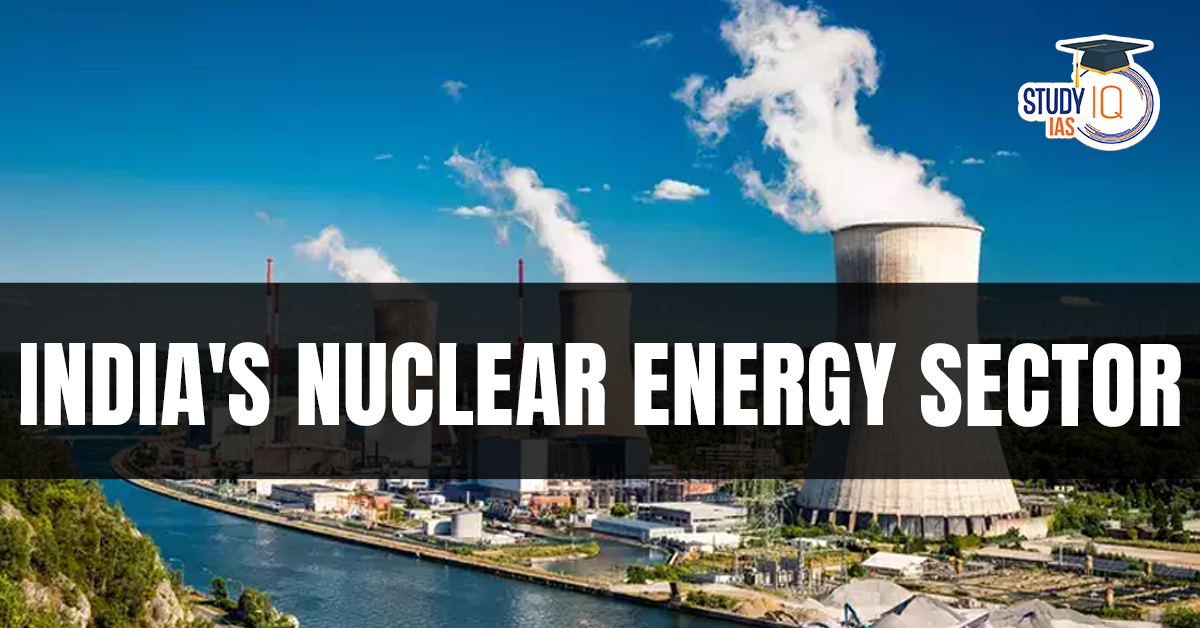Table of Contents
Context: This year’s Union budget opened the nuclear sector to private players.
Why India Needs Nuclear Energy in Its Electricity Mix
- Rising Electricity Demand: India’s electricity demand is projected to triple by 2047 due to industrialization, urbanization, and population growth.
- A diverse energy mix with nuclear ensures a stable and scalable power supply.
- Low Carbon Emissions: Fossil fuels (coal: ~70% of India’s power) contribute to severe pollution and climate change.
- Nuclear power provides baseload electricity with near-zero carbon emissions, helping India meet its Net Zero 2070
- Reliable & Stable Power Generation: Unlike solar and wind, which are intermittent, nuclear power provides continuous electricity generation.
- Reduces dependence on coal and hydro, which face seasonal and supply chain challenges.
- Efficient Land Use: Nuclear power plants require far less land than solar or wind farms for the same power output.
- Essential for India, where land availability is limited due to population density.
- Utilizing India’s Thorium Reserves: India has the world’s largest thorium reserves, offering a long-term solution for energy self-reliance.
- The three-stage nuclear programme aims to fully leverage this potential.
- Technological & Industrial Growth: Investment in nuclear energy drives indigenous R&D, job creation, and technological progress.
- India’s success in PHWRs, Fast Breeder Reactors, and SMRs showcases self-reliance in nuclear tech.
- Resilience Against Global Energy Crises: Global oil and gas markets are prone to price fluctuations and supply disruptions (e.g., the Russia-Ukraine war).
- Nuclear energy offers a predictable and long-term energy source.
India’s Nuclear Strategy
Historical Perspective
- India’s nuclear journey began with the establishment of the Atomic Energy Commission in 1948.
- Asia’s first research reactor, Apsara, was commissioned in 1956 at the Bhabha Atomic Research Centre (BARC).
- The foundation of India’s nuclear programme is the visionary three-stage strategy by Homi Bhabha, leveraging abundant thorium reserves to achieve energy self-sufficiency.
Current Status
- India’s nuclear capacity has grown from 4,780 MW in 2013-14 to 8,180 MW in 2023-24 (70% increase).
- The number of operational reactors stands at 24, with 21 more reactors (totaling 15,300 MW) at various stages of implementation.
- Annual electricity generation from nuclear plants has risen from 34,228 million units (2013-14) to 47,971 million units (2023-24).
Indigenous Technological Advancements
- India’s first indigenous 700 MWe Pressurised Heavy Water Reactor (PHWR) at Kakrapar, Gujarat, was successfully commissioned in 2023-24.
- The Prototype Fast Breeder Reactor (PFBR) achieved critical milestones in 2024, marking progress in fuel cycle efficiency.
- Fast Breeder Reactor technology, crucial for India’s second-stage nuclear programme, is nearing completion.
Future Initiatives and Expansion Plans
Small Modular Reactors (SMRs) and Bharat Small Reactors (BSRs)
- The budget allocated Rs 20,000 crore for SMR research and development.
- India aims to develop five indigenously designed operational SMRs by 2033.
- BSRs (220 MW PHWRs) are being enhanced for industrial deployment to support decarbonisation efforts.
Target for 2047
- The government has set an ambitious goal of 100 GW nuclear power capacity by 2047, a massive increase from the current 8.18 GW.
- The Nuclear Energy Mission for Viksit Bharat aims to enhance domestic capabilities and accelerate nuclear energy adoption.
International Collaborations and Private Sector Participation
- India is collaborating with Russia, France, and the US for nuclear power expansion.
- Six 1,208 MW nuclear power plants are planned in Kovvada, Andhra Pradesh, in partnership with the US.
- The Nuclear Power Corporation of India Limited (NPCIL) and the National Thermal Power Corporation (NTPC) have formed a joint venture, ASHVINI, to develop nuclear power facilities.
- Amendments to the Atomic Energy Act and Civil Liability for Nuclear Damage Act are being considered to facilitate private sector entry into the nuclear domain.
Challenges in India’s Nuclear Energy Sector
- High Initial Costs: Nuclear projects require large upfront investments, making financing a challenge.
- Fuel Supply Constraints: India relies on imported uranium from Russia, Kazakhstan, and Canada, though thorium reserves offer long-term potential.
- Public Perception & Safety Concerns: Opposition to nuclear plants due to radiation fears, despite India’s strong safety record.
- Technology Development & Delays: Fast Breeder Reactors and Thorium cycle development need significant time and R&D investments.
- Waste Management: Ensuring safe disposal and reprocessing of nuclear waste remains a challenge.
- Limited Contribution to Energy Mix: The share of nuclear power in the total electricity generation in the country was about 8% in the year 2022-23.
Proposed Reforms
- Amend outdated laws like the Atomic Energy Act and Civil Liability for Nuclear Damage Act to enable private participation and attract foreign investment.
- Develop indigenous technologies for reactors and fuel cycles to reduce reliance on imports.
- Establish permanent solutions for radioactive waste disposal.
- Increase public engagement to build trust through transparent safety measures.
- Expand training programs to build a skilled workforce for upcoming projects.


 Cotton Production in India Decline, Reas...
Cotton Production in India Decline, Reas...
 Role Of Local Communities In Conserving ...
Role Of Local Communities In Conserving ...
 Blue Flag Beaches in India List
Blue Flag Beaches in India List





















